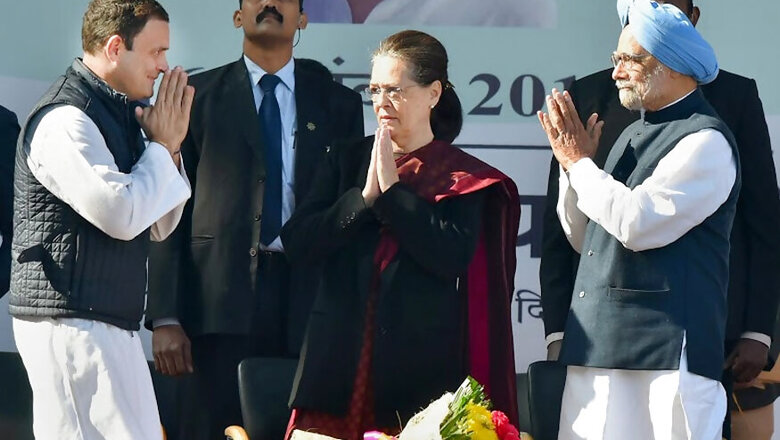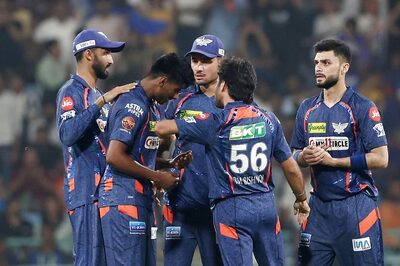
views
After more than eight decades, a slice of history is being replayed in the Congress with one member of the Nehru Gandhi family personally and formally passing on the party’s baton to another.
Sixty seven years old Motilal Nehru handed over the presidentship of the Congress party to his son Jawaharlal Nehru, then 40, at the Lahore conference in 1929 though the situation at that time was admittedly rather different. Eighty seven years later, in December 2017, mother Sonia Gandhi transferred the mantle of the organisation to her 47 years old son Rahul Gandhi who was recently elected to lead the party amidst an outcry by critics that a dynastic succession is being camouflaged as democratic.
The septuagenarian leader and the longest serving Congress president with 19 years at the helm of the organisation leaves for Rahul almost the same set of challenges that she was confronted with when she entered politics in 1997-98: salvage the Nehru-Gandhi legacy, stem the rapid decline in image, appeal and credibility of the organization and its leadership, craft a reliable social base, extricate the party from its existential crisis and revive its electoral and political fortunes by regaining the confidence of people and rebrand and restructure it.
In a way, the wheel has turned a full circle.
The big question is what role will Sonia play?
Though she was quoted by media saying that “my role is now to retire”, questions remain. Will she slip into the shadows to let Rahul grow into his new role as party chief without another power centre in the background or will she come out occasionally to advise, guide and mentor? Will she contest or leave Rae Bareli for another Gandhi.
Most Congressmen would want her around as chair of the parliamentary party, a sounding board on political and organizational issues or a link between the Congress and other opposition veterans senior to the Amethi MP in age and experience. This is clearly a far cry from the days when they doubted her ability to lead or connect with the people.
Battling Odds
Indeed, the odds, both personal and political, were stacked heavily against her — as they are for her son now — when she first set out in 1997-98 to deal with the crisis before the party. And no Nehru-Gandhi leader before her has had to reinvent herself/himself as often and frequently as she had so when she embarked on the journey that was long in more ways than one.
The 1946 born Italian who went to England to study language, came to India in 1968 as pilot Rajiv Gandhi’s bride and prime minister Indira Gandhi’s bahu, shunned politics while living in a political household, came in the public eye when Rajiv became PM after Indira’s assassination in 1984 and became the rallying point for Gandhi loyalists when he too was killed in 1991. She turned recluse for about seven years when P V Narasimha Rao and Sitaram Kesri held the reins of the government and party but emerged from her cloistered existence to take charge of the organization in March 1998 and try and revive the badly mauled Congress and Nehru-Gandhi legacy.
It is not as if Nehru, Indira Gandhi and Rajiv Gandhi did not face setbacks. Even Rahul Gandhi has humongous problems to contend with as party chief. But, unlike the others, Sonia’s challenges began with her origins itself.
She was a foreigner who spoke in accented Hindi and English which affected her communication with party leaders, workers and voters. She lacked the charisma of Nehru, Indira and Rajiv and the confidence, capability or capacity to speak extempore. Her links with party cadres and opposition leaders were tenuous at best. She was ridiculed for being a reader rather than a leader. And the Congress party she led was facing a crisis of identity.
Not many within or outside the party gave Sonia a chance either in running the party or steering it in elections, particularly after 1999 when the Congress won just 114 Lok Sabha seats—37 less than what it had in the outgoing House—though she became the Leader of Opposition.
Wary of another drubbing in 2004 under her, Congress leaders recall pleading with Sonia to bring her daughter Priyanka—who they believed was Indira-like in her physical and political demeanour—into politics. But she would retort “Why not Rahul?” thereby indicating her intent to induct and groom her son, her one blind spot, as her political heir.
Sonia, however, surprised critics and skeptics with her tenacity, determination to fight her way out of difficulties and displayed a surprising flexibility along the way to achieve her objective.
Four things stand out in particular in this regard.
One, she did not hesitate to experiment in order to rebuild the party’s fortunes. She emulated Indira in her attire, mannerisms and politics, gave a pro-poor and pro-people tilt to the party by tweaking her mother-in-law’s emotive slogan of garibi hatao with a stirring call of Congress ka haath, aam aadmi ke saath to counter the BJP-led NDA’s claim of ‘India Shining’.
Two, she showed herself to be bold and practical in abandoning the party’s 1998 Pachmarhi resolution of ‘ekla chalo’ or go it alone policy and walked the extra mile to sew up alliances with like-minded forces, including NCP’s Sharad Pawar who had split from the Congress in 1999 over her foreign origin, assuring them that the leadership issue would be settled after the polls. Her effort paid off and the Congress’s first coalition government came to power at the Centre in 2004 and then again in 2009 and lived through its ups and downs.
Three, she acquired an enviable stature when in an unheard of political move, she renounced the post of prime minister in 2004 and installed Manmohan Singh instead.
And four, as head of the National Advisory Council, she strengthened the party’s pro-people profile by ensuring that the Singh government rolled out popular programmes like the farm loan waiver and rights-based legislations like the right to information, education, guaranteed employment and food security.
These substantial and far reaching achievements in many ways eclipse her failures so that even after the party’s dismal show in 2014, her stock remained high and the opposition, none too healthy itself, kept seeking her out.
But the Congress continues to pay even now for the UPA’s failures to check prices, corruption in high places and paralysis in governance and decision-making. It could win just 44 parliamentary seats, drew a blank in 19 states and Union Territories in 2014 and lost 27 state polls between 2013 and 2017.
Though the Amethi MP is often targetted for the Congress’ dismal performance, Sonia as party chief also needs to share the blame. She failed to use the UPA rule to strengthen the organization in states like Uttar Pradesh, Bihar, West Bengal and Tamil Nadu which account for nearly 200 of 543 elective Lok Sabha seats and where the party was overrun by other forces. With the Himachal and Gujarat results expected on Monday, the party just has Punjab, Meghalaya, Mizoram and Karnataka in its kitty.
The existential crisis notwithstanding, Sonia did not go for serious introspection or soul searching either at the Congress Working Committee or other fora. Decisions taken were not adequately followed up as in the case of the 2010 Burari declaration which laid out the roadmap for tackling corruption, the 2012 dialogue session at Surajkund on the economic and political challenges before the party or the brainstorming session at Jaipur in 2013 which devolved into an emotional spectacle of Rahul’s anointment as party vice chief. Things were no better after the 2014 and subsequent debacles where Sonia’s main objective seemed to be to shield Rahul from intra-party attacks.
Indeed, one reason why Sonia did not pay enough attention to the organization is that she was focusing on Rahul, giving him a greater role in running the outfit first as general secretary in charge of frontal organizations and then as party vice president and following her illness in 2011 as the main campaigner and strategist for the national and state elections. Barring stray instances like when his campaign fetched 21 parliamentary seats in UP in 2009, the Amethi MP, who had to sweat it out for his win in Amethi in 2014, has little to show for his stewardship of the party.
For much of the latter part of the UPA’s tenure, Sonia repeatedly urged her workers to propagate the government’s achievements. But while setting up other verticals for discussion, she failed to establish a mechanism to facilitate interactions between ministers and party workers who often complained of being ignored by those who they worked to get elected. There were occasions too when she and Singh were not on the same page as, for instance, on disinvestment in UPA-1 or the move to amend the Right To Information Act and the inclusion of a reference to Baluchistan in the Indo-Pak joint statement at Sharm-el Shaikh in UPA-2.
Despite all this, on balance Sonia leaves a rich legacy as she steps down as party chief.
— Author is a veteran journalist. Views are personal


















Comments
0 comment